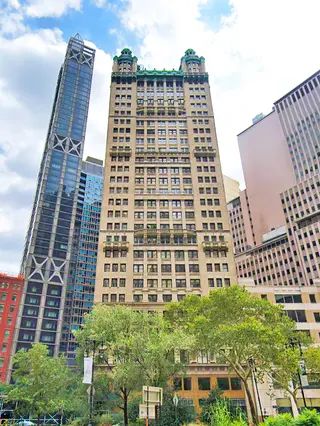 Carter Horsley
Carter HorsleyDec 23, 2011
Carter's Review
When it was completed in 1899, this 391-foot-high building was the tallest office building in the world, a title it retained until 1908 when the 612-foot-high Singer Building nearby on Broadway stole the title.
It was designed by Robert Henderson Robertson and was developed by William Mills Ivins, a former judge advocate general for New York State. In its first year of operation it was acquired by August Belmont Jr., who located the first headquarters of the Interborough Rapid Transit subway in the building. According to GreatGridlock.net, another early tenant was the Associated Press and originally, the 29-story building "incorporated 950 offices...and the main façade, clad in limestone, has its center part recessed - more prominently at the top six floors of the mass - and horizontally divided as the rows of pilasters between windows terminal at ornamental ledges at intervals."
The building also has some balconies, two four-story cupolas topped by "smaller, copper-clad lanterns with caryatids," facing City Hall Park and four sculptures of women on its base. The building has two light courts and 24 corners.
The building was designated as a landmark in 1999 and was converted in 2002 into a mixed-use building. The residential conversion by H. Thomas O'Hara turned 15 floors into 210 rental apartments and a health club. The building's lower floors are occupied mostly by J & R, the discount electronics store that occupies most of the retail frontage between Beekman and Vesey Streets facing City Hall Park.
According to GreatGridlock.net, "The main entrance is framed in a black marble portal. The lobby has its original marble walls, checkered floor and coffered ceiling, along with the old passenger elevators, arranged in an arc and tapering accordingly. However, of the nine originals, two were removed in the residential floors to make room for laundry rooms and waste chutes."
The building has a 24-hour attended, Beaux Arts lobby, laundry facilities on every floor. Apartments have high ceilings and large windows, pass-through kitchens with Golden Peach granite countertops and white wood cabinetry and GE appliances.
In his March 12, 2000 "Streetscapes" column in The New York Times, Christopher Gray said of the building that "it's still a gawky-looking thing, but the landmark 29-story Park Row Building...has nowhere near the impact in did in 1999, when it signaled New Yorkers that tall-building construction was running unchecked."
"In the 1890s," Mr. Gray continued, "advances in steel-frame construction opened up new opportunities for developers. The height of buildings had been restricted by the limits of bearing-wall construction - those more than eight stories or so had impossibly thick walls on the lower floors. But steel frames meant that the only limits were elevator service. (There were no height restrictions for commercial buildings until 1916, when a zoning resolution was passed.) The mid 1890s saw buildings getting taller and taller. Civic organizations protested that they were unsafe, that they blocked light and that they defaced the city. Early in 1896 the Chamber of Commerce announced its opposition to skyscrapers....In an 1899 article, the building s architect, Robert H. Robertson, wrote that he had tried to make the building 'look less than its real eight.' He had designed the façade, he wrote, so that the floors appeared to be in groups of four or five, ad he had added heavy horizontal forms....Architectural critics were not impressed.
In 1898 The Real Estate Record and Guide lamented that 'New York is the only city in which such a monster would be allowed to rear itself.' The Record and Guide called the cupolas 'ineffectual and insignificant' and said that the huge blank side walls were 'absolutely inexpressive and vacuous.'"
In 1929, Clinton & Russell redesigned the lower floors of the building to attract new tenants and Mr. Gray noted that "much of the heavy stonework was replaced with gleaming bronze."
The building has spectacular views, especially of the great Woolworth Building right across City Hall Park, there is excellent public transportation and the Brooklyn Bridge is just over a block away.
The building also has the address of 13 Ann Street and 3 Theater Alley.
While the building's cupolas are a bit two small to make up for the loss of the "twin towers" of the destroyed World Trade Center, and not graceful enough to take credit for the romantic twin towered residential palaces of Central Park West, they are highly visible reminders of the great glories of Lower Manhattan's pre-One Chase Manhattan Plaza skyline when topping buildings was bubbly important, not a flat glass of champagne.

- Rental built in 1899
- Converted in 2007
- 9 apartments currently for rent ($3.7K to $7K)
- Located in Financial District
- 210 total apartments 210 total apartments
- Doorman
- Pets Allowed
 6sqft delivers the latest on real estate, architecture, and design, straight from New York City.
6sqft delivers the latest on real estate, architecture, and design, straight from New York City.
